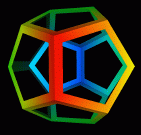

 Web size -- Screen size |
| Click here to view a VRML 2.0 model of a color coded dodecahedron (5K). |
| ... you may check out this Quicktime recording of the spinning VRML object. |
|
|
Return to VRL Home Page http://www-VRL.umich.edu |
|
Return to Project Overview |